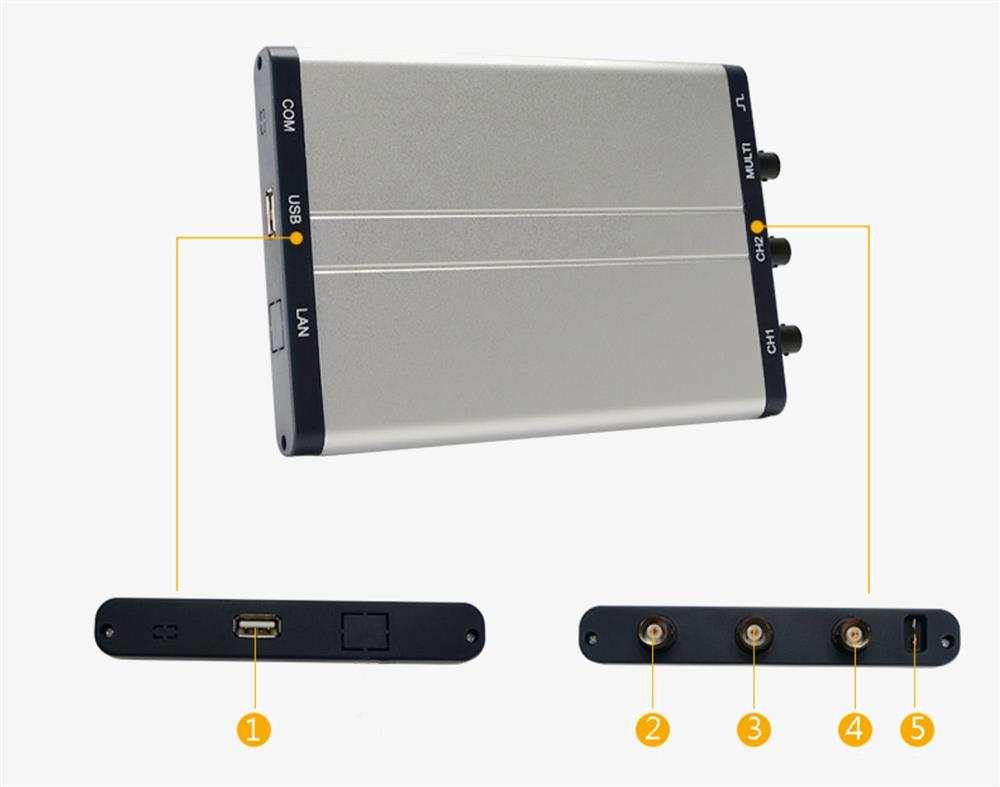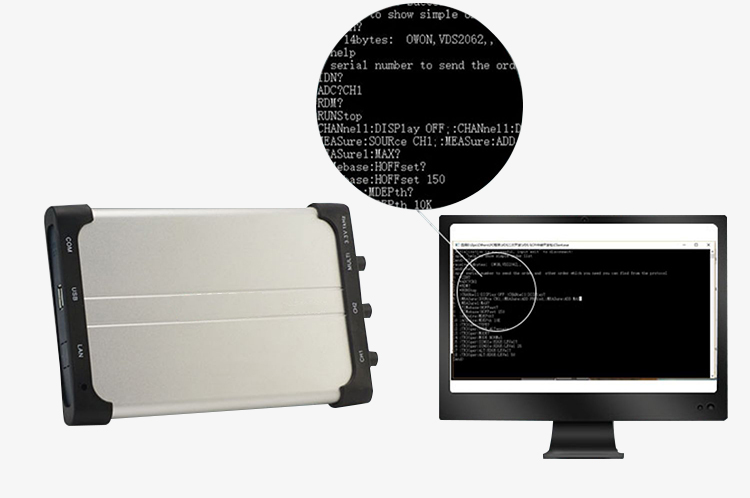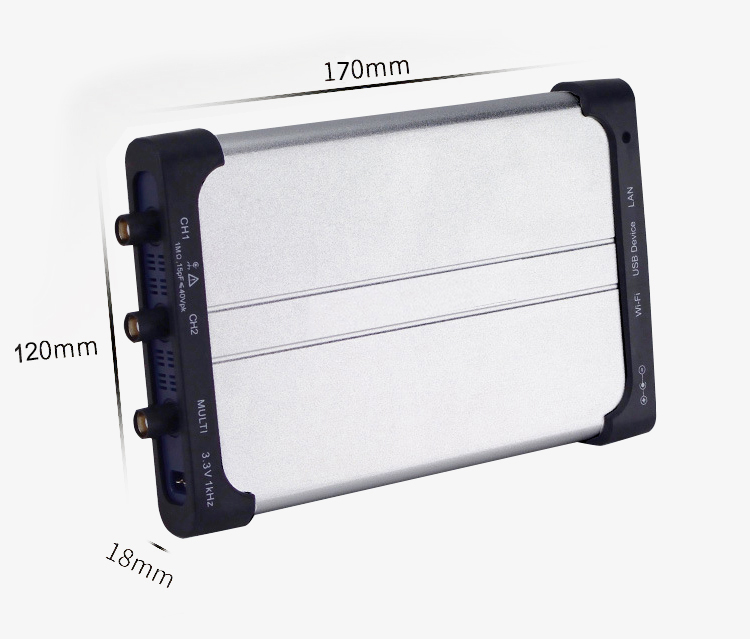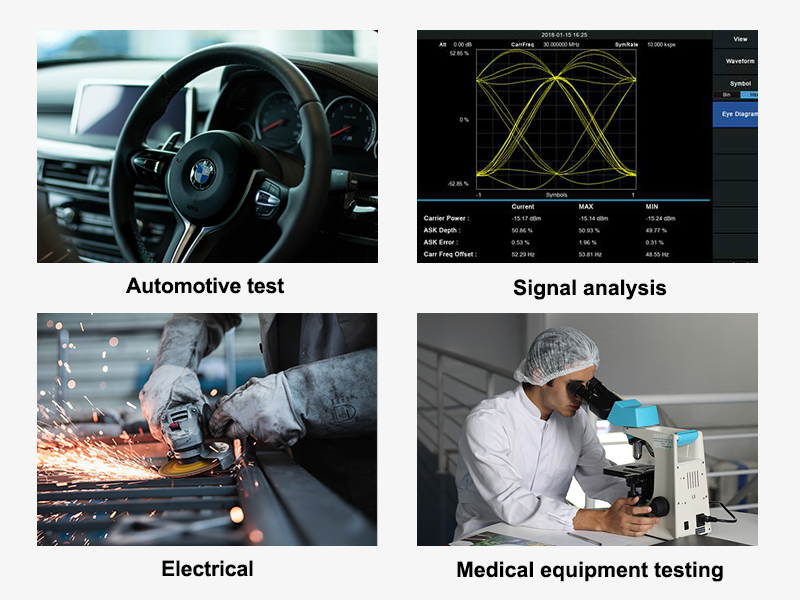The 25 MHz PC oscilloscope with 100 MSa/s sampling rate, 2 analog channels, 5K record length. Heat-resistant and scratch-proof compact case, powered by connecting to computer USB ports. 23 measurement functions, PASS/FAIL Check, be suitable for technical application.

PC oscilloscope interface details
- USB interface
- Channel 1 signal input
- Channel 2 signal input
- External trigger input, trigger output or pass/fail output
- Probe compensation

Support SCPI
- Support SCPI secondary development
- Shock isolation function to protect the safety of computers and equipment during transient electric shocks.
Dimension Unit (mm)

Application
The main application of a SISCO oscilloscope is used to display the waveforms of signals. It can be used in many fields such as automotive test, signal analysis, electrical, transducer test and measurement, electrical equipment design, medical equipment testing field, etc.

| Model | SISCO-VDC-1022 | SISCO-VDC-1022I |
| Max. Input Voltage | 40V(DC + AC peak) | 400V(DC + AC peak) |
| Communication Interface | USB2.0 | USB2.0 (isolation) |
| Bandwidth | 25 MHz | |
| Channel | 2 Channel+ Multi | |
| Sample Rate | 100 MSa/s | |
| Horizontal Scale (s/div) | 5ns/div - 100s/div, step by 1 - 2 - 5 | |
| Record Length | 5K | |
| Input Impedance | 1MΩ ± 2%, in parallel with 10pF ± 5pF | |
| Vertical Sensitivity | 5mV/div - 5V/div | |
| Vertical Resolution | 8 bits | |
| Trigger Type | Edge, Pulse, Video, Slope, and Alternate | |
| Automatic Measurement | Vpp, Vavg, Vrms, Frequency, Period, Vmax, Vmin, Vtop, Vbase, Vamp, Overshoot, Pre-shoot, Rise Time, Fall Time, +Width, -Width, +Duty, -Duty, DelayA→B , DelayA→B |
|
| Waveform Math | +, -, *, /, FFT | |
| Power Supply | ≤2.5W | |
| Dimension (W * H * D) | 170* 18* 120mm | |
| Weight | 0.26 kg | |
Accessories
- CD ROM
- USB cable
- Probe
- Probe Adjust
- Silicon Gel Case
- Quick Guide
Q1: Can an oscilloscope measure DC voltage?
A1: DC voltage can be measured using either an oscilloscope or a digital multimeter. Each piece of testing equipment has its advantages and disadvantages.
Q2: What is the maximum frequency for the oscilloscope?
A2: System bandwidth determines an oscilloscope's fundamental ability to measure an analog signal - the maximum frequency range that it can accurately measure. Entry-level scopes will often have a maximum bandwidth of 100 MHz. They can accurately (within 2%) show the amplitudes of sine-wave signals up to 20 MHz.
Q3: What is the record length for an oscilloscope?
A3: The record length, measured in points or samples, divided by the sample rate (in Samples/second) specifies the total time (in seconds) that is acquired. Example: With a record length of 1 M points and a sample rate of 250 MSa/sec, the oscilloscope will capture a signal of 4 msec in length.
Tips: What is a PC oscilloscope?
A PCO or a PC-based oscilloscope is a form of oscilloscope based on a special printed circuit board that could be an ISA card, a USB, or a Peripheral Component Interconnect (PCI) card. The popularity of PC-based oscilloscopes is primarily attributed to the prevalent use and affordability of both laptop and desktop computers. Unlike traditional oscilloscopes, which are stand-alone equipment, PC-based oscilloscopes are also transportable. The interface acquisition of the PCO depends on the application which requires more system capability. It can be a video game port — when low-frequency signal and sound are required- or a regular audio card.
Thank you for buying industrial test and measurement equipment on SISCO.com, all products sold by SISCO and the partner cover a 12 months warranty, effective from the date of receiving the products.
What is covered?
SISCO is responsible for providing free spare parts, and free technical support to assist the customer to repair the defective products until the problem is solved.
What is not covered?
- Product purchased from anyone other than a SISCO store or a SISCO authorized reseller.
- Expendable parts.
- Routine cleaning or normal cosmetic and mechanical wear.
- Damage from misuse, abuse or neglect.
- Damage from use of parts other than SISCO approved.
- Damage from use outside the product’s usage or storage parameters.
- Damage from use of parts not sold by SISCO.
- Damage from modification or incorporation into other products.
- Damage from repair or replacement of warranted parts by a service provider other than a SISCO authorized service provider.
- Damage caused by the application environment not meeting the product usage requirements and the failure to perform preventive maintenance.

